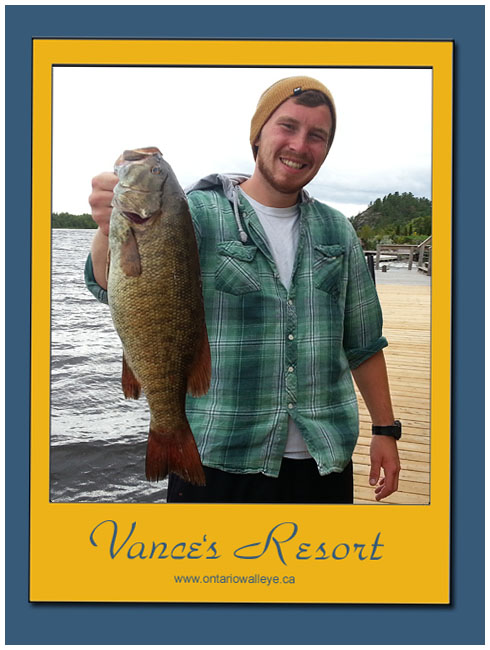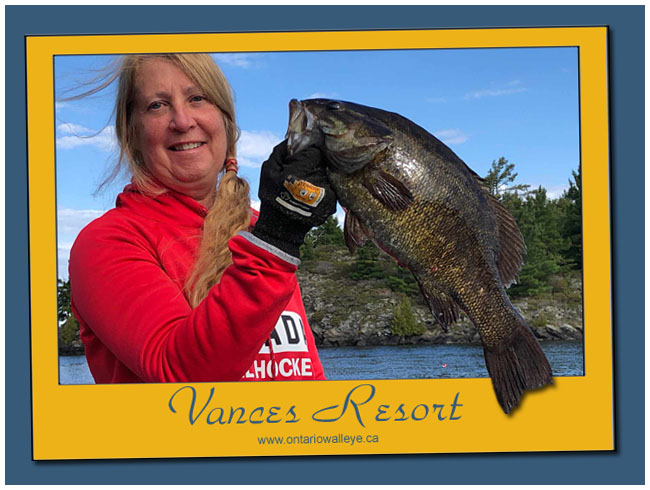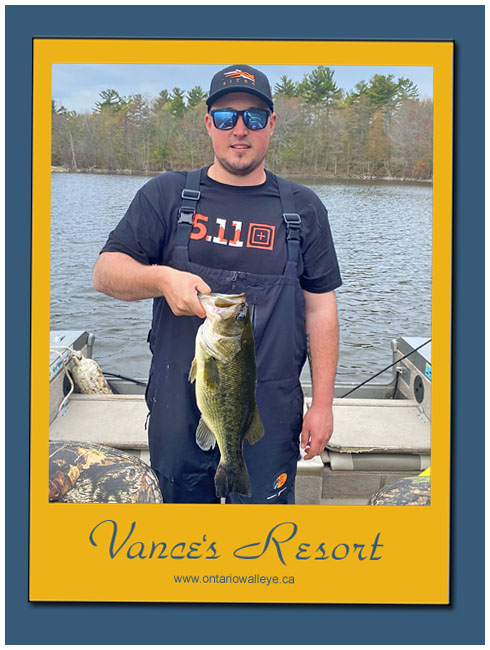
 Smallmouth Bass: The legendary Smallmouth Bass of Northern Ontario with leave a smile on your face and sore arms. This fish, pound-for-pound, is the hardest fighting fersh-water fish, especially in the cool clean waters of Northern Ontario. The North Channel is big water and produces big fish. The Spanish River not only offers the best spawning grounds for Smallmouth Bass but the outflow of the river forms a huge river delta, which is a rich ecosystem supplying an endless banquet of food including minnows, frogs, bugs and crayfish. The bass are well fed and get fat. Smallmouth Bass are common up to 4 pounds. Guests do catch bigger ones in the 5 to 6-pound range. There have been bass caught over 7 pounds but that would be a rare trophy. If you target Smallmouth you will see their feeding patterns go up and down. One day you may catch 5 to 10 bass and the next day catch 30 to 50 bass. There are tons of bass but from day-to-day different tactics and baits may be needed. Atmospheric pressure, size of surface waves and light penetration are huge factors in determining the day's bass tactics.
Smallmouth Bass: The legendary Smallmouth Bass of Northern Ontario with leave a smile on your face and sore arms. This fish, pound-for-pound, is the hardest fighting fersh-water fish, especially in the cool clean waters of Northern Ontario. The North Channel is big water and produces big fish. The Spanish River not only offers the best spawning grounds for Smallmouth Bass but the outflow of the river forms a huge river delta, which is a rich ecosystem supplying an endless banquet of food including minnows, frogs, bugs and crayfish. The bass are well fed and get fat. Smallmouth Bass are common up to 4 pounds. Guests do catch bigger ones in the 5 to 6-pound range. There have been bass caught over 7 pounds but that would be a rare trophy. If you target Smallmouth you will see their feeding patterns go up and down. One day you may catch 5 to 10 bass and the next day catch 30 to 50 bass. There are tons of bass but from day-to-day different tactics and baits may be needed. Atmospheric pressure, size of surface waves and light penetration are huge factors in determining the day's bass tactics.
Largemouth Bass: Largemouth Bass are not a dominant species in the area and their numbers are nowhere close to the smallmouth. The Spanish River Delta does have lots of shallow weedy areas with patches of Lily Pads and Bulrushes where you will find Largemouth Bass. You are not going to see monsters like you see in southern waters but largemouth up to 5 pounds do get caught. Our location is basically the most northern range of the Largemouth Bass.
• View Regulations for the Spanish River (zone 10 - Adobe .pdf)
• View Regulations for North Channel & Georgian Bay (zone 14 - Adobe .pdf)
• View Big Map of North Channel
 Download Adobe .pdf Reader for Free
Download Adobe .pdf Reader for Free
Smallmouth Bass: Micropterus dolomieui Lacepede - a.k.a.--> brown bass, browny, bronzeback, smallie
The Smallmouth Bass is a slender, streamlined-shaped fish, which pound for pound puts up a fight that rivals any of the popular fresh water gamefish. No other fish jumps like a Smallmouth.
Smallmouth Bass are omnivorous in the food they consume. The Smallmouth Bass is a predator, feeding mostly on fish, crustaceans and aquatic and terrestrial insects. Where crayfish are abundant, they frequently comprise over two-thirds of the food.
Now that we know what they feed on, here are some tips when fishing for old Bronzeback in Canadian waters:
The most obvious spots to fish are rock shoals and drop off points. They also can be found in deeper water where the concentration of feeder fish are more abundant. A depth finder is invaluable in finding the best structure.
To cover large areas of water, diving crankbaits like Cotton Cordell's Rattlin Spot and the Rapala Shad Rap in silver or crawfish patterns are quite effective. When fishing shallow rock shoals, white and yellow spinnerbaits as well as shallow diving crankbaits have proven deadly. In deeper waters, a 1/4 to 3/8 oz jig head tipped with chartreuse, black, yellow or white Mister Twister grubs are also effective. Slowly bouncing these jigs off rocky bottoms will surely entice the most wary Bronzeback. If fishing deep water in late summer or early fall, try bouncing a worm colored Tub Jig off the bottom. When Smallmouth do go deep, they seem to like the 30 to 40 foot depth range.
 When These Methods don't work:
When These Methods don't work:
Some days you can throw every lure in the book at them and they will not hit. That's when you have to switch to live bait. Rock shoals and rocky points are the best spots for Smallmouth. What you should do is get a bass hook and put a big worm on. Let the worm dangle off the hook. Don't keep hooking it until it's a ball on your hook. Use light line like 4 or 6 pound test so you can cast far. With this method, you don't use any weight.
Cast your big worm at the shore's edge or over top of a shoal and let the worm slowly sink. As soon as it sinks down a couple of feet, gently pull the worm towards you until it hits the surface then let it sink down again. It's almost like you are taking long slow jigs. But make sure you pull it very slowly and gently. You will find that most of the time, the Smallmouth will hit the worm as it is sinking. You could put a weight about 3 feet up the line like a stretched Caroline Rig but when you are fishing in the rocks, a weight will get snagged. It's best not to use a weight even if you find it frustrating to cast.
You can use the same method with a Crayfish or a minnow. You can also use a small float about 2 feet up from the bait and cast over the rocks and just wait.
When the Largemouth Bass are really feeding:
Bass like to hide in the thick weeds and grasses that you find along the shore. The bass have a high tolerance to warm water with low oxygen which give them the ability to come closer to shore then other fish and take advantage of the food that's available such as bigger insects, frogs, mice, snakes or even baby birds. If the bass are really feeding heavily, they will come out of the grass, wild rice or cattails to the weed line to hunt down minnows. In this case you can just throw spinner baits and drag them along the weed bed. This is a relaxing type of fishing because you do not have the aggravation of taking weeds off your line every cast. A spinner bait, tinsel tail spinner or even a surface lure like a Spook or a Hula Popper will work great. Generally the better colors are white, black or worm color.
When the Largemouth Bass slow down.
When the bass start to slow down, which is usually from too much sun or heat, they tend to go back into the grass or underneath floating islands of cattails. They can also go deep. First, I will talk about bass taking cover in shallow water and show a weed-less Texas Rig and Carolina Rig. The only difference between the two rigs is a Carolina Rig has the slip sinker up the line about 12 inches. Texas Rigs should be used where there are lots of logs and snags while the Caroline Rig should be used in the weeds or Lily Pads. There is also a difference in the motion. A Texas Rig gives more of a vertical jigging motion while with the Carolina Rig, the rubber has more of a dart motion as it follows the sinker.
How to Make a Texas Rig or Carolina Rig:
Step 1) Get yourself a slip sinker, a bass hook with a medium to long shank and a bass rubber. I have used a red rubber because it looks neat on the Internet but I have actually never caught a bass using these red rubbers. I like to use White, Black or worm color.

Step 2) Stick your hook into the rubber.

Step 3) Pull the hook right through so the eye of the hook (where you tied the line on) is hidden inside the rubber.

Step 4) Twist the hook around 180 degrees and then shove the hook back into the rubber. Just put the hook in deep enough that you have broken the surface on the other site but do not have the hook sticking out. The whole idea it to keep the rig weed-less or snag-less.

Step 5) For a Texas Rig, leave the sinker to slid down right to the hook.

Step 6) For a Carolina Rig, slide the slip sinker up the link about 6 to 12 inches and then place a little split shot on the line to hold the sinker in place.

In some lakes, the bass will go deep and hide down in the deep weeds. I have seen some really big Largemouth Bass being caught by people who were Walleye fishing. If you are not getting them along the shore, try pulling a Texas Rig through the thick weeds or drift over a deep weed bed with a spinner and a long dangling worm.
 When they are not hitting rigs or lures:
When they are not hitting rigs or lures:
Some times you just have to use live bait. As a kid, I always hunted Largemouth Bass along the shore with a hook, float and a bucket of minnows. Worms, small frogs and crayfish work good but I think Chub, Sucker or Shinner minnows are the best. Get a medium size hook and a small float. Have the float about 6 to 12 inches up the line (depending how deep it is) and hook your minnow on. Hook the minnow in the mouth. Don't hook the minnow in the back because they die twice as fast.
Just paddle or use your electric motor and move along the shore. Cast your minnow at the edge of the grass or lily pads and just wait. The very best spot is under a big log or under a floating mass of cattails (Bulrushes). When you get a big mass of cattails coming out from the shore, the edges are usually floating because the wave actions keeps the roots of the cattails from planting in the bottom. Some of the biggest bass I have ever caught were hiding under these cattails.
Cast your minnow to the edge and wait. A bass might look at a minnow for 5 minutes before taking it. If you think nothing is going to happen, then slowly bring the minnow back to you. Sometimes the bass hit when the minnow starts moving away. There is one rule that's always true. The slower your float goes under and the slower the bass swims away with your minnow, the bigger he is. So if you see your minnow racing around, then it's probably a perch, crappy or a rock bass.
Pro Bass Fisherman use heavy 15 to 25 pound test because they are speed fishing. They are not there to enjoy the day or the fight of the fish. They want to bring the fish in as fast as possible so they can win money. If you are fishing bass for enjoyment, than use 6 or 8 pound test line. You will get more hits, you can cast farther and it's ten times more fun bringing the fish in. With 15 to 25 pound test line, you might as well be bringing in an old shoe.